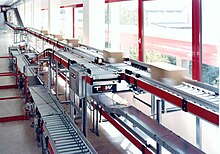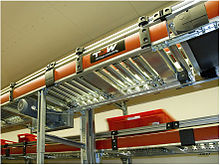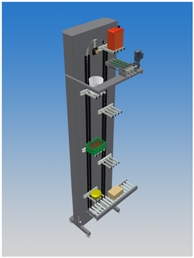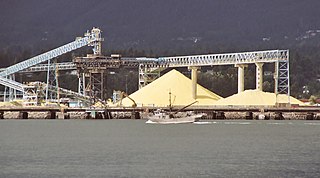
A conveyor belt is the carrying medium of a belt conveyor system. A belt conveyor system is one of many types of conveyor systems. A belt conveyor system consists of two or more pulleys, with a closed loop of carrying medium—the conveyor belt—that rotates about them. One or both of the pulleys are powered, moving the belt and the material on the belt forward. The powered pulley is called the drive pulley while the unpowered pulley is called the idler pulley. There are two main industrial classes of belt conveyors; Those in general material handling such as those moving boxes along inside a factory and bulk material handling such as those used to transport large volumes of resources and agricultural materials, such as grain, salt, coal, ore, sand, overburden and more.

Logistics automation is the application of computer software or automated machinery to improve the efficiency of logistics operations. Typically this refers to operations within a warehouse or distribution center, with broader tasks undertaken by supply chain engineering systems and enterprise resource planning systems.

A reclaimer is a large machine used in bulk material handling applications. A reclaimer's function is to recover bulk material such as ores and cereals from a stockpile. A stacker is used to stack the material.

A lift table is a device that employs a scissors mechanism to raise or lower goods and/or persons. Typically lift tables are used to raise large, heavy loads through relatively small distances. Common applications include pallet handling, vehicle loading and work positioning. Lift tables are a recommended way to help reduce incidents of musculoskeletal disorders by correctly re-positioning work at a suitable height for operators. Lift tables lend themselves to being easily adapted to a specific use. They can work in hostile environments, be manufactured in stainless steel and have equipment like conveyors, turn-tables, barriers and gates easily added to their deckplates.

A Slip sheet is “a corrugated, solid fiber, or plastic sheet onto which a unit load can be assembled. A protruding short panel can be grasped by the jaws of a pull-pack truck and the load pulled back onto the pull-pack platform.”
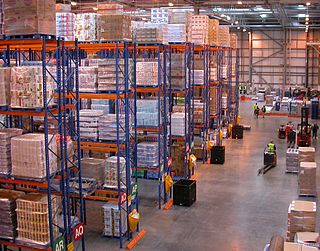
A distribution center for a set of products is a warehouse or other specialized building, often with refrigeration or air conditioning, which is stocked with products (goods) to be redistributed to retailers, to wholesalers, or directly to consumers. A distribution center is a principal part, the order processing element, of the entire order fulfillment process. Distribution centers are usually thought of as being demand driven. A distribution center can also be called a warehouse, a DC, a fulfillment center, a cross-dock facility, a bulk break center, and a package handling center. The name by which the distribution center is known is commonly based on the purpose of the operation. For example, a "retail distribution center" normally distributes goods to retail stores, an "order fulfillment center" commonly distributes goods directly to consumers, and a cross-dock facility stores little or no product but distributes goods to other destinations.

A silo is a structure for storing bulk materials. Silos are used in agriculture to store fermented feed known as silage, not to be confused with a grain bin, which is used to store grains. Silos are commonly used for bulk storage of grain, coal, cement, carbon black, woodchips, food products and sawdust. Three types of silos are in widespread use today: tower silos, bunker silos, and bag silos.

A loading dock or loading bay is an area of a building where goods vehicles are loaded and unloaded. They are commonly found on commercial and industrial buildings, and warehouses in particular. Loading docks may be exterior, flush with the building envelope, or fully enclosed. They are part of a facility's service or utility infrastructure, typically providing direct access to staging areas, storage rooms, and freight elevators.
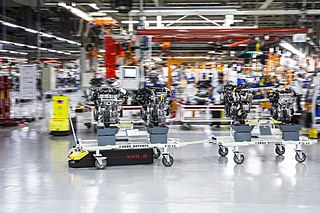
An automated guided vehicle (AGV), different from an autonomous mobile robot (AMR), is a portable robot that follows along marked long lines or wires on the floor, or uses radio waves, vision cameras, magnets, or lasers for navigation. They are most often used in industrial applications to transport heavy materials around a large industrial building, such as a factory or warehouse. Application of the automatic guided vehicle broadened during the late 20th century.

An automated storage and retrieval system consists of a variety of computer-controlled systems for automatically placing and retrieving loads from defined storage locations. Automated storage and retrieval systems (AS/RS) are typically used in applications where:

A coal preparation plant is a facility that washes coal of soil and rock, crushes it into graded sized chunks (sorting), stockpiles grades preparing it for transport to market, and more often than not, also loads coal into rail cars, barges, or ships.
Automated Truck Loading Systems - ATLS has been commonly used in the material handling industry to refer to the automation of loading or unloading trucks and trailers with product either on or without pallets, slip sheets, racks, containers, using several different types of automated guided vehicle systems (AGV) or engineered conveyor belt systems that are integrated into vehicles, automating the shipping / receiving and logistics operations.

Pallet rack is a material handling storage aid system designed to store materials on pallets. Although there are many varieties of pallet racking, all types allow for the storage of palletized materials in horizontal rows with multiple levels. Forklift trucks are usually required to place the loaded pallets onto the racks for storage. Since the Second World War, pallet racks have become a ubiquitous element of most modern warehouses, manufacturing facilities, retail centers, and other storage and distribution facilities. All types of pallet racking increase storage density of the stored goods. Costs associated with the racking increases with increasing storage density.

Material handling equipment (MHE) is mechanical equipment used for the movement, storage, control, and protection of materials, goods and products throughout the process of manufacturing, distribution, consumption, and disposal. The different types of equipment can be classified into four major categories: transport equipment, positioning equipment, unit load formation equipment, and storage equipment.
A tube chain conveyor moves materials inside a tube, pulled by a chain. It offers a convenient way for conveying bulk material from one location to another, and also multi-axially. Tube chain conveyors are used for transporting, feeding, dosing, distributing and discharging pourable bulk materials.

A checkweigher is an automatic or manual machine for checking the weight of packaged commodities. It is normally found at the offgoing end of a production process and is used to ensure that the weight of a pack of the commodity is within specified limits. Any packs that are outside the tolerance are taken out of line automatically.

The term unit load refers to the size of an assemblage into which a number of individual items are combined for ease of storage and handling, for example a pallet load represents a unit load which can be moved easily with a pallet jack or forklift truck, or a container load represents a unit for shipping purposes. A unit load can be packed tightly into a warehouse rack, intermodal container, truck or boxcars, yet can be easily broken apart at a distribution point, usually a distribution center, wholesaler, or retail store for sale to consumers or for use.

A chain conveyor is a type of conveyor system for moving material through production lines.
A Drum handler is a piece of mechanical equipment that is used to securely grip, lift and transport cylindrical modules such as steel drums, barrels, plastic drums and fiber drums. It has spring-loaded metal arms to create a tight and secure grip. This equipment is commonly used in chemical and petroleum industries, as well as industries that require shipping and storing of cylindrical modules.
A vertical conveyor is a machine which can be used to move products automatically from one level to another. These machines are typically referred to as VRC's. However, the industry does not have universal standard terminology. These lifts can also be referred to as: material lift, parts lift, pallet lift, vertical lift, freight lift, utility lift, box lift, cargo lift, platform lift, baggage lift, vertical conveyor, and dumbwaiter. None of these terms use the word "elevator". This is because that term usually is used when referring to machines that transport people from one level to another and these lifts are not designed or legally allowed to transport people.
M.Marcu-Pipeline Conveyors (theory,photos,state of the art 1990-Pneumatic Pipeline conveyors with wheeled containers) at page 45 in: "Material handling in pyrometallurgy: proceedings of the International Symposium on Materials Handling in Pyrometallurgy, Hamilton, Ontario, August 26–30, 1990-Pergamon press"



